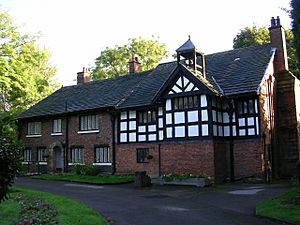Clayton, Manchester facts for kids
Quick facts for kids Clayton |
|
|---|---|
| Metropolitan borough | |
| Metropolitan county | |
| Region | |
| Country | England |
| Sovereign state | United Kingdom |
| Post town | MANCHESTER |
| Postcode district | M11 |
| Dialling code | 0161 |
| Police | Greater Manchester |
| Fire | Greater Manchester |
| Ambulance | North West |
| EU Parliament | North West England |
Clayton is a lively area in Manchester, England. It's located about three miles east of the city centre. The name Clayton comes from the Clayton family, who once owned much of the land here. The River Medlock flows through Clayton Vale, a beautiful green space nearby.
Historically, Clayton was part of Lancashire. It was a township under Droylsden until around 1890. At that time, Manchester's boundaries changed, and Clayton became part of the city. Other areas like Blackley, Crumpsall, Moston, Openshaw, and Gorton also joined Manchester then.
Contents
Clayton's Sporting History
Manchester United's Early Home
Did you know that Clayton was once home to Manchester United? From 1893 to 1910, the famous football club, and its earlier team Newton Heath L&YR, played here. Their stadium, called Bank Street, was huge. It could hold up to 50,000 fans!
The stadium was covered on all four sides, which was quite impressive for its time. After Manchester United moved to their current stadium, Old Trafford, Bank Street was badly damaged in a storm. The remaining parts were soon taken down.
Manchester Velodrome
Today, a car park for the Manchester Velodrome stands on the site of Manchester United's old stadium. The Manchester Velodrome is a special track for bicycle racing. It opened in Clayton in September 1994. It's a key place for cycling events in the UK.
Discover Clayton Hall
Clayton Hall is a fascinating old building from the 15th century. It's located on Ashton New Road in Manchester. You might miss it at first, as it's hidden behind trees in a small park. This hall is very important. It's a Grade II* listed building, which means it's a historic site. It's also a scheduled ancient monument.
A Moated Medieval Site
Clayton Hall is special because it's a rare example of a medieval moated site. This means it was once surrounded by a ditch filled with water for protection. The hall was first built for the Clayton family. Later, in 1194, it passed to the Byron family. The famous poet Lord Byron was a member of this family.
The Byrons lived there until 1620. They then sold the hall to two merchants from London, George and Humphrey Chetham. Humphrey Chetham is well-known for starting Chetham's School and Library in Manchester city centre.
Civil War and Preservation
During the English Civil War, soldiers loyal to the King (called Royalists) stayed at Clayton Hall. This was before they attacked Manchester. Legend says that Oliver Cromwell, a key leader during the war, even spent three nights at the Hall afterwards.
In 1897, Manchester City Corporation bought the building. This was a great step, as it helped save the historic hall for future generations.
Clayton Today
Philips Park and Cemetery
Philips Park is a lovely green space on the south side of the River Medlock. On the north side, you'll find Philips Park Cemetery. Philips Park holds a special place in history. It was Manchester's very first public park!
Mark Philips, who was a Member of Parliament for Manchester, opened the park in 1846. It was the first park of its kind in all of Great Britain and Ireland. It set an example for many other towns and cities across Britain to create their own public parks. The park was designed with walking paths, large lakes, and glasshouses for exotic plants. It's also famous for its annual tulip festival, which still takes place every year. Philips Park Cemetery opened later, in 1863.
Homes in Clayton
Most of the homes in Clayton today are council homes. The first of these homes were built around the late 1920s. They were constructed near the border of Droylsden. More homes were built later on land that used to be a brick works, a golf course, and even cricket and football grounds. The building from the old cricket and football grounds is still standing. It's now used as a boxing club.
Frank Pritchard, who grew up in Clayton in the 1920s, wrote about it in his book East Manchester Remembered. He said that Clayton was seen as a "rather posh area" back then.
Church and Community
St. Willibrord's Church
Father Alphonsus is the current priest at St. Willibrord's Church. This church is part of a new parish called The Parish of the Holy Spirit. It also includes two other nearby churches: St Bridget's in Bradford and St Anne's in Ancoats.
St. Willibrord's Church had some changes made to its inside in 2006-07. The back of the church became a place for local community gatherings. Many charity fund-raising events are organized there. More improvements were made in 2019-2020. New gas central heating was installed, making the church warm for the first time in many years.
Church of St Cross
The Church of St Cross was built in the 19th century. It was designed by William Butterfield, an architect known for building churches on a budget. This building is unique because of its patterned brickwork. It also has a richly decorated inside.



